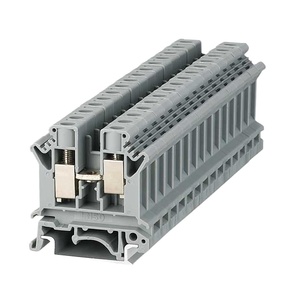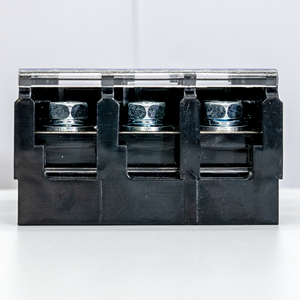
All categories
Featured selections
Trade Assurance
Buyer Central
Help Center
Get the app
Become a supplier

(2752 products available)






















High voltage terminal blocks are important electrical instruments, particularly for safely and efficiently connecting high voltage wires. Often found in industries dealing with power generation, transmission, and heavy machinery, they handle substantial voltages and currents, ensuring safety and stability in electrical connections. Below are some common types.
High voltage terminal blocks in the strip type form are elongated in shape and have several connection points situated in a row. This type is excellent for high voltage power supply systems, as one block can connect numerous wires. Systematic and easy to install, these are often found in switchboards or distribution panels.
This type of terminal block comes with removable plugs that can be inserted or withdrawn easily. A safe and simple way to make or break connections, plug-in types are used in sensitive equipment. Their flexibility makes maintenance or troubleshooting easier as one can replace or test components without disturbing the whole system.
A feed-through terminal block allows wires to be connected from one end to another. Its simple design makes it suitable for basic connections but ensures high voltage safety. It is commonly found in low-to-moderate high voltage applications in power distribution cabinets.
The grounding high voltage terminal blocks help in wire connections and safe grounding operations. ENSURING electrical systems' safety by providing a low-resistance path for fault currents, these block types are often integrated INTO high voltage power transformers or electrical panels to diminish the risk of electrical shocks or fires.
As the name suggests, grounding and isolating terminal blocks are combined into one. They offer both grounding and safe cut-off functions. These are desirable in complex systems needing effective fault management and easy disconnection. These blocks are common in security-sensitive electrical installations.
When choosing high-voltage circuit breakers, one needs to be aware of the durability and materials since they directly impact performance in challenging environments.
Resistance to Environments: High voltage terminal blocks must be resilient against dust, moisture, and extreme temperatures. Many blocks are housed in sealed enclosures or were coated with protective materials to minimize damage from harsh operating conditions in outdoor or industrial settings.
Thermal Capacity: High voltage capacitors generate heat through continuous operation or heavy currents. Terminal blocks built with materials that can withstand high temperatures will not degrade easily, hence ensuring a brief long-term performance and a decline in maintenance needs.
Shock and Vibration Resistance: In many industrial applications, the equipment is subject to constant vibrations and shocks. Hence, durable terminal blocks are designed to withstand these mechanical forces without loosening connections or sustaining physical damage. These blocks are often used in manufacturing plants or on transport systems.
Insulating Material: Polyamide and PVC (polyvinyl chloride) are often used as insulating materials for high-voltage terminal blocks. These materials have a high dielectric strength and are capable of protecting electric currents from passing where they are not meant to. They are also very heat resistant and hence fail-safe in electrical insulation.
Conductive Elements: Stainless steel and brass are most commonly used conductive materials in high voltage terminal blocks because of their excellent conductivity and resistance to corrosion. Stainless steel is often used in environments sensitive to corrosion, such as coastal areas or places with high humidity. Brass, on the other hand, is used for its strength, cost-effectiveness, and good conductivity.
Housing: The outer shell of high-voltage terminal blocks is engineered so as to protect inner components from environmental damage. High strength materials, such as polycarbonate, serve this purpose well, as they are strong yet transparent, thus possible visual inspection of the interior components.
High voltage terminal blocks connect and manage electricity in various industrial and commercial conditions. Below are some common scenarios where these terminal blocks are critical to operation reliability and safety.
In power-generating systems such as nuclear, coal, and natural gas power plants, high voltage terminal blocks are used to connect generator output wires to the electrical distribution system. The terminal blocks manage the large currents and voltages generated in power plants while ensuring safety and avoiding any electrical hazards. They are also designed to withstand the extreme environments found in power plants.
In electrical substations, high voltage terminal blocks are employed to maintain connections between incoming and outgoing power lines and provide a secure point for grounding connections. This is crucial for pathing fault currents in case of electrical surges. The blocks operate in high voltage areas and provide great insulation and durability.
Terminal blocks carry high-voltage electrical equipment such as motors, pumps, and compressors in large industrial manufacturing plants. They withstand dust, moisture, and extreme temperatures, hence designed for these hazardous environments. Moreover, some are designed for shock and vibrations experienced in these places.
In systems of power generation, such as solar panels and wind turbines, high-voltage terminal blocks connect wires and ensure safe electrical disconnections. They are suitable for outdoor usage, as they are resistant to corrosion and weather elements. Finding quick and easy maintenance in plug-in terminal blocks is helpful in renewable energy systems for frequent disconnections during servicing in safety conditions.
High-voltage terminal blocks are used in electrical systems for airplanes, ships, and railways to withstand vibrations and give a path for fault currents. This provides safety in transport systems by securing the block where wiring carries huge electrical currents and voltages.
All these applications underscore the importance of high voltage terminal blocks as reliable and safe connectors in different industries for the effective management of high-voltage electrical systems.
Choosing the right kind of high voltage wirring terminal blocks can be very difficult, considering functionality and application factors. Below are some key factors to consider when selecting these.
The first consideration when choosing a terminal block is the nominal voltage it can handle. The terminal block should match the system requirements or exceed them to ensure reliability and safety. Under or over-voltage conditions lead to system failures and hazardous electrical risks.
Material is also important, just like functionality. Insulation material should be heat-resistant, such as polyamide or PVC. Durability should also consider environmental factors like moisture, dust, and extreme temperatures. Additionally, terminal blocks made from corrosion-resistant materials, for example, stainless steel, are more desirable for outdoor application.
Sometimes, limited space calls for high installation density. In such cases, choosing terminal blocks with tightly packed connection points saves space yet enables efficient wiring. Strip-type terminal blocks are often used in compact power distribution cabinets to reduce space.
High voltage connectors should be chosen based on load current capacity and system requirements. The terminal block must support the maximum anticipated current in the system to avoid overheating and electrical failures. Not only does this ensure safety, but it also confirms optimal performance for the system.
There exist many types of high voltage terminal blocks, but each serves a different purpose. Feed-through types are the most basic and serve the function of wire connections. Grounding types provide safe grounding for electrical systems. Plug-in types offer the flexibility of easy maintenance. Combination types are ideal for complex systems that need effective disconnection and fault management.
A. High voltage terminal blocks connect and disconnect wires in electrical systems, manage the flow of HT currents, and ensure safety.
A. Power plants, substations, industrial manufacturing, renewable energy, and transportation all use high voltage terminal blocks since they deal with high electrical voltage.
A. Insulation materials for high voltage terminal blocks are often polyamide and PVC, while conductive elements can be stainless steel or brass for conductivity and resistance to corrosion.
A. Several high voltage terminal blocks are designed to be moisture, dust, and extreme heat-resistant, while some are shock and vibration-resistant for efficient functioning in different environments.
A. Matching the system requirements ensures safety and reliability. Failed systems cause hazardous electrical risks, while over-voltage conditions do the same.